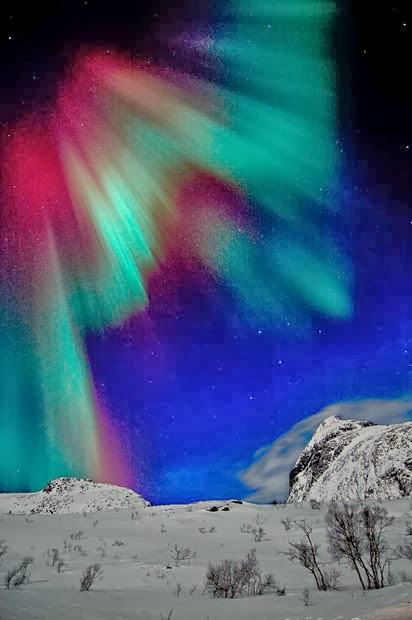For this postcard from planet Earth I've decided to cheat a bit on my own rules and pick a rock that isn't necessarily of the Earth, even if it is on the Earth. Mainly because I wanted to write about something close to my heart.
Let me explain.
Let me explain.
I recently read this article in Scientific American. The research it highlights describes how interactions between solar wind and interplanetary dust particles can produce water. This got me thinking about how the Sun is a vital piece in creating our habitable little part of the solar system / galaxy / universe. (It also links nicely to my previous postcard, where I discuss how water might originally have been brought to Earth.)
The solar wind is a stream of charged particles (mostly electrons and protons) released from the Sun's upper atmosphere. This stream can vary, over time and from location to location around the Sun, in its density, temperature, and speed.
 |
| During solar flares, strong blasts of solar wind are fired through the solar system. Credit: NASA |
You see, as a PhD student I waited (not necessarily patiently) for sunspots to erupt on the Sun's surface and for solar flares to fire X-rays through the solar system, towards the Moon's surface where an orbiting spectrometer onboard India's Chandrayaan-1 lunar satellite would detect the resulting X-ray fluorescence and provide me with some much needed data to analyze for my thesis research. Unluckily for me, I was doing my PhD when the mission was active, during the deepest solar minimum in over a century (solar cycles normally last about 11 years and most solar flares occur during the peaks of activity). Needless to say, my desired events were few and far between. Indeed that solar minimum lasted much longer than had been anticipated and the current cycle was almost a full year 'overdue' by the time it started.
Nowadays I still keep a watchful eye on the Sun's activity. Mostly because I work on the analysis of similar X-ray fluorescence data from NASA's MESSENGER mission that is currently orbiting Mercury. And it seems that predictions for the length and strength of the cycle change from week to week. For instance, this recent article discusses whether the Sun might be headed into another 'Maunder Minimum'. This was an approximately 70-year period (1645–1715) when the Sun was almost completely devoid of sunspots. The Maunder Minimum coincided with the middle of the Little Ice Age, during which there was a series of particularly frigid northern hemisphere winters.
 |
| Schematic illustration of MESSENGER's X-Ray Spectrometer in operation around Mercury. Credit: NASA / The Johns Hopkins University Applied Physics Laboratory / Carnegie Institution of Washington |
 |
| The magical northern lights. Credit: Bjorn Jorgensen / National News & Pictures |
And some research has shown that the variable output of ultraviolet radiation through the course of a solar cycle can be tied to terrestrial climate changes. Climate scientists are now trying to make reliable climate predictions on decadal timescales, therefore sound solar predictions are important inputs for their models.
So with all this research in solar physics, why are predictions for the Sun's activity so seemingly unreliable? Physicists have observations from a host of solar satellites at their disposal, yet they seem to still be in the metaphorical dark. Perhaps this complex problem will just a little bit longer to unravel, or maybe the timescales of study are too short?
And that's where my rule-bending rock postcard comes in.
I wonder if we can use material that the Apollo astronauts brought back from the Moon to increase the length of time over which we can study the Sun and its solar wind output. Back in 1970, scientists made measurements of noble gases (such as helium and argon) that were trapped inside tiny pieces of the lunar soil. And it is thought that those noble gases were implanted into the soil as the solar wind bombarded the Moon's ancient surface. So by studying these trapped pieces of the solar wind we can learn more about how the Sun has changed through time. If we had enough samples from discrete layers in the lunar surface we could even build up a record of this solar wind material that might help place the Sun's modern activity into a larger context and give the solar physicists a helping hand.
 |
| Color photograph of Apollo 11 lunar soil sample 10084. These grains are between 9000 and 10,000 mm. Credit: NASA / Johnson Space Center |
No comments:
Post a Comment